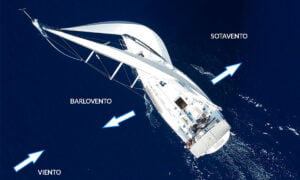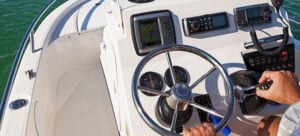The bearing courses are those of a length and aft. The most important thing about these directions is related to safety. Due to a wave, or due to the helmsman's inattention, the main can jibe alone and the boom, in its abrupt change of side, can violently hit the unsuspecting crew.
During navigation on bearing courses, it is vitally important that the crew members keep their heads below the height of the boom at all times and that the helmsman not lose concentration at any time to avoid “unintentionally gybing.” Other effects of this unexpected jibe can be serious damage to the boat, a sudden strong list, etc.
As an additional safety measure, in a round stern it is a good idea to secure the boom with a rope, carrying a tie to the bow so that it does not fall.
Regarding navigation in outriggers we are going to see several topics, the different strategies for going down to leeward, and the rigs and sails that can be used (genaker and spinaker). We start in this post with the Genaker.
The Genaker
Rig
Also called (spi) asymmetric. Due to its size and composition it is like a spinnaker (round sail with a large surface) but the rig is more similar to that of the genoa. It consists of a halyard, sheet and tack head and also has an edge of the sail that is the luff, etc.
The first thing before hoisting it, will be to prepare the maneuver. The rig consists of the sail in a bag, two sheets, a halyard on the mainmast, the tack rope and finally the pulleys through which we will pass the ropes.
The sheets will have a shackle hooked to one of the necks. A sheet will be placed on each side. The end of the rope that does not have the shackle remains at the stern and passes through a pulley that will be fixed somewhere on the stern side. From the block, the rope will go to some winch and will be wound around it.[1]. No stopper knots (eights) should be tied in the stern sheet bows (as is done with the genoa). In this way, in case of problems with the gennaker, the sheets can be released completely. The rest of the sheet is carried forward, always passing it outside the stanchions and shrouds. The rope shackle is currently hooked on some handrail in the bow. These shackles usually have a ring or a cable as a “trigger” that allows them to open quickly and easily.
At the bow, a pulley must be fixed and a rope passed through it that will be attached to the tack of the sail. The neck of this bow rope will also have to have a shackle or loop attached to it. Instead of the bow pulley, it is also possible to use the free sheave of the anchor to pass the tack line. The opposite end of the rope can be fixed to a cleat in the bow, but another option, if the rope is long, is to take it to the cockpit winches, thus allowing us to regulate the distance between the tack and the bow once we have hoisted it. sailing.
Once it has been decided which will be the leeward side, the bag with the sail is hooked on the leeward bow, in any position that is further forward than the shrouds. If the sail is well stored inside the bag, the three handles of the sail must be close at hand and almost outside the bag. It is necessary to identify which of the grips is the halyard grip and which is the tack and sheet grip respectively.
We now have the rig ready and all that remains is to hook the halyard and tack ropes to the corresponding grips. The two sheets are attached to the clew. It is very important that the halyard, the tack line and the sheets pass outside the genoa (more to leeward), if we do not do this, the lines will become tangled when we furl the latter.
[1] Be careful here, since the winch is further forward than the block, this is an atypical case in which a rope reaches the winch from stern to bow, and it is then necessary to pay attention to winding it in the correct direction of the clockwise. Generally the rope arrives from the bow and is located to the right of the winch but in this case the rope will have to enter from the left of the winch!!
Hoisting and trimming
The gennaker is hoisted to the lee of the genoa, which causes the first sail to rise unwind. Otherwise the sail would begin to carry too much wind, making hoisting much more difficult. For the candle to come out of the bag correctly, it is advisable for a person to stand next to the bag and help the candle to get out of it without any mess, etc. Another person will pull the halyard very quickly, it being better to do it from the mast. Immediately you will have to hunt the lee sheet and on the other hand furl the genoa.
During the time the sail remains hoisted, it is necessary for a person to constantly trim the sail with the help of the sheet. To do this, this person has to go with the sheet to windward because only from there can he observe what the genaker luff is doing. The idea is to leave the sail as open as possible until the luff begins to fall inward (called "ear"). Therefore, the sheet is opened as much as possible and when the sail makes an “ear”, we hunt a little. As the sail exerts a lot of pressure, it is convenient (or necessary) to make several turns of the sheet around one or more winches to be able to catch it.
When we go across, the genaker will generally be more hunted. If we take a long or aft course the sail will have to be more open. (In this sense it is like a genoa.). The genaker is not suitable for going round stern and requires long courses. If we go too high the sail loses pressure and then the pattern must luff. But if what we want is to gain leeward, then the skipper must be attentive and take advantage to arrive if the sail gains pressure.
One option is to sail with the “donkey ears”, which involves gybing the main but not the genaker. The skipper must maintain a stable course so that the sails hold on his side. If the main tends to fall you have to luff but if it is the gennaker that deflates you will have to move a little. This is the same as saying, as a helpful “trick”, that you have to bring the rod towards the falling sail (as long as we are sitting to windward).
Lastly, jibing with the genaker involves a certain risk of the sail becoming entangled with the genoa furler and you will have to be very careful that this does not happen. It is advisable to place a crew member in the bow to help pass the ropes and sail during the maneuver.
Pick up the candle
A course is taken in which the sail goes with the least possible pressure. As soon as the halyard is released, a crew member, located at the entrance to the cabin, picks up the sheet and cloth, quickly throwing the entire assembly into the cabin. At the same time, another person gradually flattens the halyard, usually from the mast. It is advisable not to release the halyard suddenly to prevent the sail from falling into the water. An option if it is not very windy, and there is no danger of the sail flying away, is to start the maneuver by releasing the tack (open the shackle at the end of the sail) and quickly retract the sheet and sail.
A final step is to store the candle inside the bag. Unless the sail is required again on a later board, this operation can be postponed to the end of the day, but it is very important to do it correctly in any case. We will find the sail crumpled on the floor of the cabin. The genaker should be stored inside the bag, so that the sail is not twisted and has the three handles visible and almost outside of it. To do this, first take the halyard grip in your hand and run with your other hand (or with the help of another person) one side of the sail, folding it, until you reach the other grip. The same is done with the other side of the sail and the three fists are folded together. The remaining belly of the genaker is put into the bottom of the bag until the fold with the three fists together are at the top.





